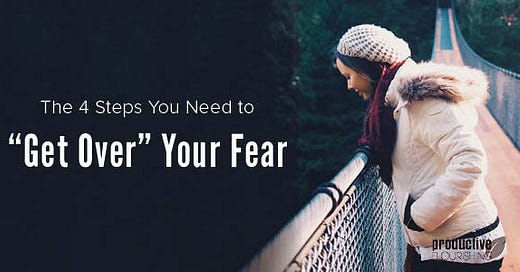The 4 Steps You Need to "Get Over" Your Fear

Editor’s note: This is a guest post from Breanne Dyck.
It didn’t look nearly so tall when I was standing on the ground.
But there I was, perched precariously at the top of a 40-foot telephone pole. My feet resting on two metal loops, as I contemplated my next move.
They called it the Leap of Faith, and somehow, I had to get my feet from those loops to the top of the pole, so I could stand up… and then jump off.
I’m not sure how long I was up there. Putting one foot on the top surface, starting to push myself up, and then dropping back down again.
No matter how hard I tried, I couldn’t will myself through it.
The Antidote to Fear
There’s a story that the antidote to fear is to just try harder.
Close your eyes, grit your teeth, and just do it, whatever “it” is.
There’s only one problem with that idea:
It doesn’t work.
Trust me; I know. I spent many years trying to make the concept work. All it led to was frustration.
“Why wasn’t it working? What was I doing wrong? Why couldn’t I just get past this fear?”
It wasn’t until recently that I learned the fault wasn’t with me. It’s that no one had actually, really taught me what it means to “just do it.”
What I’ve learned is that “getting over fear” isn’t a process with just one step.
It’s four.
Step 1: Acknowledge the Fear
Acknowledging the fear means not only knowing that you’re afraid but also knowing what you’re afraid of.
Sometimes, this step is simple: if you’re standing atop a 40’ pole, it’s pretty obvious what you’re afraid of.
Other times, though, the fear is more subtle and harder to identify because fear can be, and often is, covered up by other emotions.
For example, I’ve learned my fear will sometimes manifest in anger. Because I’ve learned this, though, I can now recognize my anger for what it is: a cover-up for fear.
When that anger surfaces, I can ask, “What am I afraid of?” and, so long as I am willing to let the answer come, I will discover the fear lurking beneath.
Step 2: Recognize What the Fear Represents
Knowing what you are afraid of isn’t enough, though.
The truth is, what we think we are afraid of is only a shadow of our true fear.
Imagine your fear is a monster, lurking around the corner. Before you see the monster itself, you see its shadow.
So, in order to dismantle the fear, it’s not enough to just attack the shadow. We must be able to get to the monster itself. (Tweet this.)
Doing that requires asking not only what we are afraid of but also why we are afraid of it.
What does the fear represent?
For example, a fear of falling could represent a loss of control for one person. For another, it could represent helplessness. For another, it could represent pain and injury — maybe even death.
Each of those roots are different, even though the fear itself appears the same on the surface. Understanding the difference and what your fear represents for you is key, because it’s what allows you to move onto step three.
Step 3: Appreciate the Fear
I know, I know. “Appreciate the fear” sounds like some new-age nonsense. Bear with me.
Fear exists in the amygdala, the oldest part of the brain. Throughout our evolution, the amygdala has remained relatively unchanged. Why? Because its job is as relevant now as it ever was. It keeps us safe.
Before we can move past fear, then, we need to first acknowledge it and second, appreciate it. After all, it is doing a very, very good job at keeping us safe.
Of course you wouldn’t want to jump off a telephone pole! That is, objectively speaking, a terrible idea.
And not just because you could be harmed, but because of what the fear represents to you.
If the fear were just about the potential to be harmed, then your amygdala would be soothed by the presence of the harness and the ropes and the helmet on your head.
But none of those things address what the fear represents. So before fear will let us jump, metaphorically or literally, we need to acknowledge what the fear is keeping us safe from, and then thank it for trying to keep us from that awful result.
Step 4: Make a Different Choice
A funny thing happens when you appreciate your fear.
The fear calms down.
It’s as though the part of your brain that says, “Oh, so you get what I was trying to protect you from. Not just the fall, but everything else that falling represents.”
As soon as that happens, the fear takes a step back and allows you to choose between staying where you are, perhaps frozen in fear, or moving forward, despite the fear.
I’m sure people much more experienced and educated in this area than I am could tell you exactly why this is the case. I just know that this step makes all the difference.
Every time I appreciate and thank my fear, I’m able to make the choice: the choice to get on top of that pole; to stand up straight; to take a deep breath…
And jump.
Know This: The Fear Will Return
I only did the Leap of Faith one time.
But I know if I were to ever do it again, the fear would return.
Because that’s what fear does.
It keeps coming back, over and over, to keep us safe.
In that regard, maybe the most important lesson I’ve learned about fear is that it’s a good thing to be afraid.
It teaches us where our growth edges are; it shows us where we could be putting ourselves at risk.
That’s its job, and it does a fine job of it.
But should you want to move ahead in spite of the fear and in spite of the risks… I hope these four steps will make that process easier.



